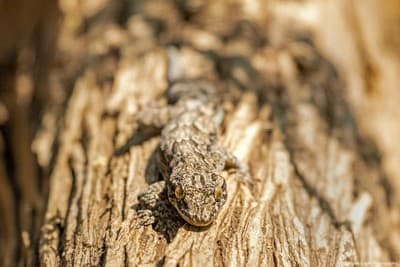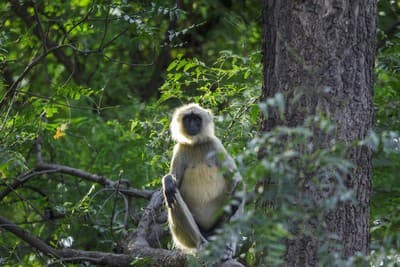Conservation and Science Writer with WCT, Purva Variyar, and naturalist Gaurav Shirodkar talk about an obscure, yet enchanting destination in Maharashtra called the Lonar crater. Extra-terrestrial origins, unique soda lake, rare microbial life, and thriving forest, they discuss it all!
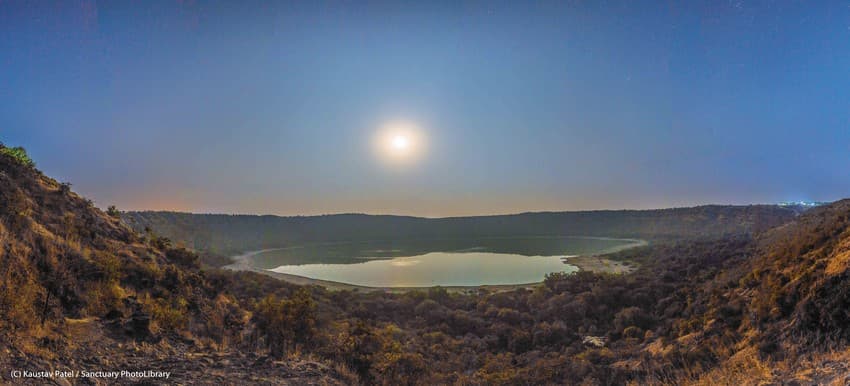
The moon sparkles in the night sky as it lights up the Lonar crater. The impact crater was formed around 50,000 years ago when a meteor hit the earth. Today, it cradles a lake at the centre and a dense forest along the rim. Photo: Kaustav Patel
We stood on the rim of a large bowl and looked down at its spectacular contents. There it was, the mystical place we had been meaning to visit ever since we had read about it. The Lonar crater sat draped in its finery of green forest circling the still lake at its centre, as if protecting it from alien intruders, who would first have to brave their way through the steep, dense vegetation, almost as if having to earn the right to reach the lake.
It was about two years ago that we had first read about the formation of the Lonar crater. It was admittedly the alien association that had caught our fancy. We simply had to see this place for ourselves and given its location where it sat right here in our very own state of Maharashtra, just about 500 km. from Mumbai. There is an undeniable mystery about the crater. We felt it even while in Lonar.
How It Came To Be
Thousands of stellar bodies and debris called asteroids and meteoroids pass within striking distance of the Earth everyday. They range from the size of dust particles to those spanning kilometres and weighing millions of tonnes. And each time our planet is struck by a sizable extra-terrestrial body, it leaves its mark in the form of an impact crater on the Earth’s surface. And each one makes for a great story. The most famous one being the theory that talks of a 10 km. wide asteroid that blazed through space, cut through our atmosphere and hit the ground in the Yucatán Peninsula in Mexico to form the 65-million-year old Chicxulub crater that is believed to have triggered the mass extinction in which dinosaurs famously perished.
Here, we are going to talk about a lesser known, but equally special impact crater that formed very recently in terms of the geological time scale. About 40,000 to 52,000 years ago, in what is today a small town in Buldhana district, in the state of Maharashtra, a massive meteor weighing more than a million tonne struck the Earth with hypervelocity, creating a one of a kind impact crater, 1.8 km. wide and more than 150 m. deep. What must it have been like at that moment of massive collision when tremendous shock waves ran through the Earth’s crust, sending debris flying all around, before it cooled down?
For years, experts debated the origin of this crater that formed in the basalt rock of the Deccan Plateau for it was considered to be of volcanic origin, or a geobleme if you will, which means formed of terrestrial processes. In the latter half of the 20th century, further studies and observation revealed its likeness to an extraterrestrial impact crater and experts realised that it was an astrobleme, a crater of an extraterrestrial source. Unmistakable signs such as the well-shaped circular circumference, ratio of the depth to diameter, and especially the characteristic raised rim about 20 m. above ground level on the outside of the impact radius proved that it was indeed an impact crater. Another important clue was the presence of fallen debris from the impact of the meteor with the ground, around the site of collision, making up what is called in scientific jargon, an ejecta blanket. The Lonar crater’s ejecta blanket ranges over one kilometre, including the rim of the crater. But what ultimately proved without doubt the meteorological origins of the Lonar crater was the discovery of shatter cones, breccia and maskelynite. Maskelynite is a type of glass that forms when the hypervelocity impact of a meteor or asteroid shocks the plagioclase, a rock-forming mineral, into vitrifying.
Living, Breathing Biome
This grand crater that formed when a meteor came hurtling through space before it rammed into the Earth at this very spot where we were now standing, is today, a thriving, living, breathing, self-contained biome. The fact that a cosmic hand had a role to play in the formation of this cosy, little forested space with a near perfect circular-rimmed lake sitting in the centre of the crater, added a certain magical aura to the place. But every image we had seen prior to our visit failed to do justice to the actual vision before us.
The stark habitat difference in the land outside and within the crater – it is as if the landscape within the crater has been crafted and managed in vitro! The vegetation inside the crater is a mix of dense evergreen forest at the base of the crater, almost at the level of surface of the lake, and a mix dry deciduous forest on the inner slope of the rim. This forest lies in stark contrast to the dry, arid terrain outside the crater.
The Lonar Lake’s unique characteristics have attracted scientists and researchers from across the world. To begin with, this is a soda lake, which means it is both alkaline and saline at the same time. It is, therefore, a rare and delicate ecosystem. Though, this extreme nature of the soda lake (pH level more than 10.5) does not see fishes and other such aquatic life take seed here, the rare and hardy bacteria known as extremophiles thrive in these hostile and highly salty waters. These bacteria boast of being descendants of Earth’s earliest living lineage which appeared when the planet was anything but livable. They are, today, found to be thriving in extremely hostile conditions such as the hot and highly toxic undersea volcanoes and sulphur vents!
But, it is not just the unusual geochemistry and biological aspects that make Lonar special. The Lonar crater having formed on Deccan Plateau’s basalt rock is rather similar to the basaltic rock surfaces on the moon and terrestrial planets such as Mars, Venus and Mercury. And that is why scientists find it to be an analogous study site for studying these celestial objects! Lonar has been able to give us insights into the lunar! (Pardon the wordplay).
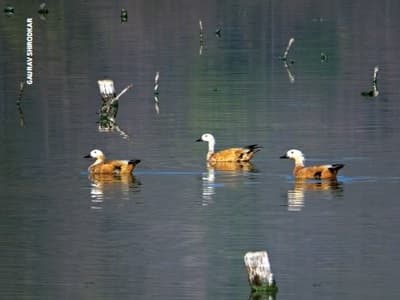
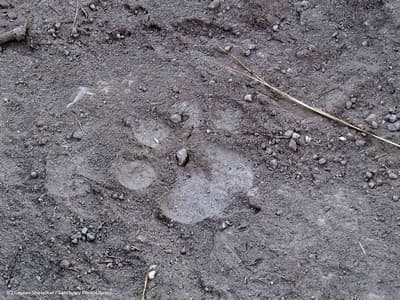
‘Biodiversity within the crater was an indication of a healthy, teeming forest. The authors sighted over 120 species of birds in and around the crater, including Ruddy Shelducks (top left) foraging in the Lonar Lake. A leopard’s pugmark (top right) sighted in the forest along the rim of the crater. A gecko (Hemidactylus sp.) (bottom left) and gray langur (bottom right) make for photogenic subjects. Photos: Gaurav Shirodkar and Sanyam Gupta
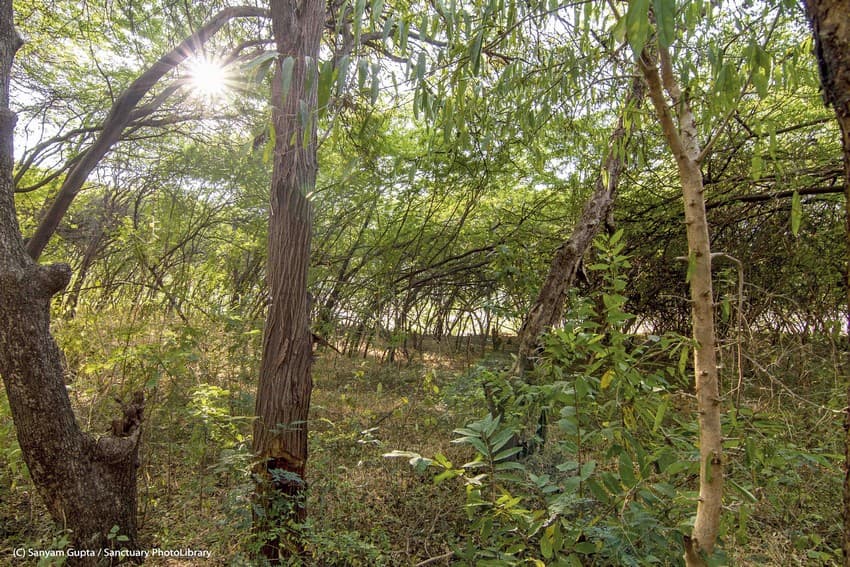
The vegetation inside the crater is a mix of dense evergreen forest at the base and a mix of dry deciduous forest on the inner slope of the rim. Photo: Sanyam Gupta
We can still vividly recall that poignant moment of taking the first steps onto the rim and looking down at the bottom of the crater where sits this beautiful, idyllic lake! And then we made the descent down only to run into surprisingly dense thickets of forest before stepping out on the cracked surface of the lake bed. The biodiversity of this region was undoubtedly impressive.
We were thrilled to have sighted over 120 bird species in and around the crater including the Common Quail, which immediately disappeared into the bushes on spotting us. There were waterfowl including the Ruddy Shelduck, Indian Spot-billed Duck, Northern Shoveler, Common Teal, Little Grebe among others which were happily foraging in the lake. Flocks of Yellow-footed Green Pigeons were seen along with the cacophonous Plum-headed Parakeets on the treetops while a few Indian Grey Hornbills were hovering over Ficus trees. On the second day, as we headed out to the crater early in the morning, we saw a breathtaking sight of hundreds of bee-eaters flying above us. That evening, we were greeted by the calls of the Mottled Wood-owl and the Indian Nightjar. We had heard of records of flamingos using the Lonar Lake as a pit stop to bulk up on protein and mineral rich cyanobacteria called spirulina, which is found here in large amounts.
We cannot forget the rush we felt on running into fresh leopard scat while making the descent to the Lonar Lake. So fresh that a blade of grass was still in the process of rebounding to its upright position amongst the fecal remains, and that unmistakable stench of a leopard nearby said it all. We had missed it by a hair’s breadth! Like a saying goes, ‘One does not see a leopard, the leopard allows itself to be seen.
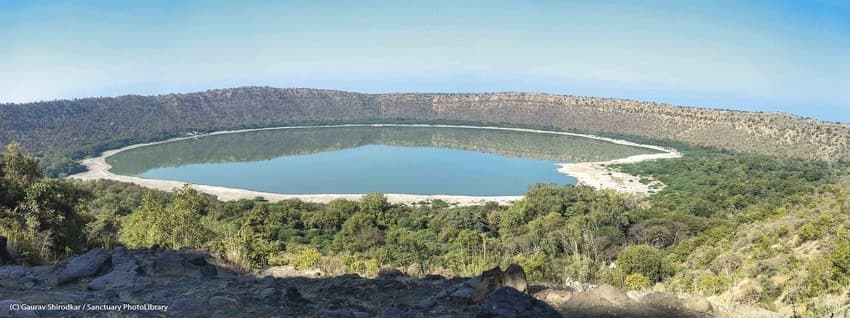
The Lonar Lake is essentially a soda lake i.e. it is simultaneously alkaline and saline. It harbours a unique ecosystem comprising a mix of rare microbial life. Photo: Gaurav Shirodkar
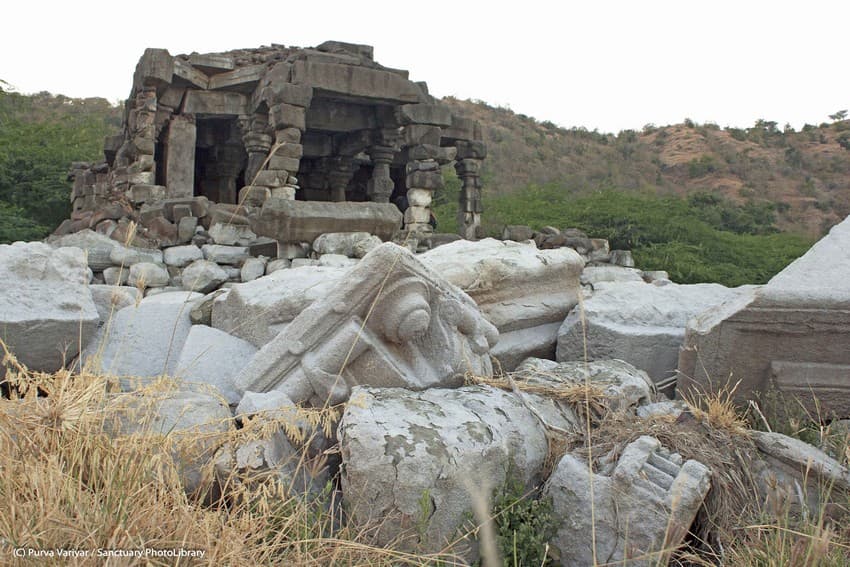
Ruins of what is possibly an ancient sun temple, one of several such temples found within the crater. Photo: Purva Variyar
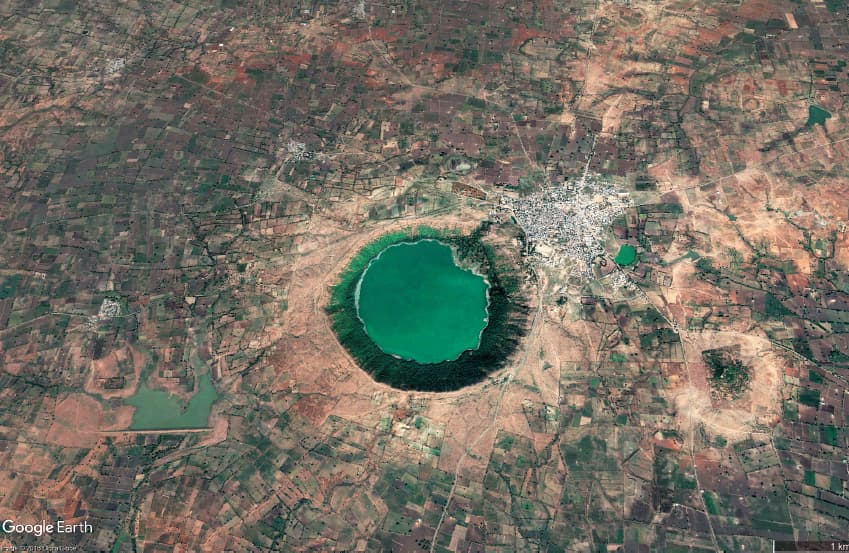
A Google Map screen grab clearly shows the prominent geography of the impact crater against the rest of the landscape. Photo: Google Earth
All’s Not Well
We were frankly quite relieved to learn that the Lonar crater was part of a wildlife sanctuary. Though it is also a notified National Geo-Heritage Monument, the lake faces several threats. Pollution due to sewage water and human activity in and around the crater is said to be affecting its hyper alkalinity and salinity, thereby threatening its sensitive ecosystem. Excessive water from the lake has been usurped for farming and other non-agricultural activities. Experts claim that the lake’s surface area has shrunk by a staggering 100 metres in the last 3 to 4 years! Borewells installed within less than 100 meters of the crater rim and food joints and other commercial ventures nearby are pumping out the groundwater reserves meant to feed the lake. Some of the streams flowing into the lake have either dried up or have been blocked.
To think that this bowl of booming biodiversity, rare microbial life, geomagnetic properties, unique mineral groups and one of the best preserved sites of impact craters in the world, should have been treated as an immense source of pride for our state and country! But instead, the apathy of the government only shone brighter when it struck another nail in the coffin by ordering to reduce the Eco Sensitive Zone surrounding the lake to a mere 100 metres from the initial 500 metres. Many experts and green activists saw red, and justifiably so.
Lonar And Climate Change
We must strive to protect this geographical marvel from degrading. One way to do so is to create awareness among people about this magical place so that it encourages tourism, thereby proving beneficial for the people of Lonar. Sustainable tourism if carried out with the involvement of locals, through education and training, will not only provide alternatives but also create a sense of pride. The people of Lonar are already inextricably bound to the lake historically and culturally. The myriad temples, mostly old and in ruins, are a testimony to this fact. And these magnificent temples definitely add to the allure of the place! Experts claim that the methane-eating bacteria or the methanotrophs, found in the lake could be studied and used in our quest to combat global warming. Unless we protect sites such as Lonar, we will lose the opportunity to even be able to explore such potential climate change-combatting solutions.
The sooner we realise that it is to nature that we will have to look to for solving all our global and pressing problems, the better it will be for us and for our incredible ecosystems such as the Lonar crater! On our last night here, as we stood on the rim facing the almost-full moon that arose from behind the crater, its glassy reflection fell on the still waters of the lake. The ethereal scene was a befitting one, as we looked to the sky where it all began.
First published in Sanctuary Asia, April 2018
——————————————————————————————————————————————————————
About the authors: Purva Variyar is a conservation and science writer at the Wildlife Conservation Trust, India.
Gaurav Shirodkar is an avid naturalist and likes travelling to wild places and loves to capture nature through his lens.
Disclaimer: The authors are associated with Wildlife Conservation Trust. The views and opinions expressed in the article are their own and do not necessarily reflect the views and opinions of Wildlife Conservation Trust.
——————————————————————————————————————————————————————
Your donations support our on-ground operations, helping us meet our conservation goals.
——————————————————————————————————————————————————————
Related Links
- The Impact Of One Health On Conservation
- Protecting Madhya Pradesh
- Rise in Wildlife Crime: Pandemic’s Intensifying Collateral Damage
- Mitigation on roads near Tadoba must, rules NGT

